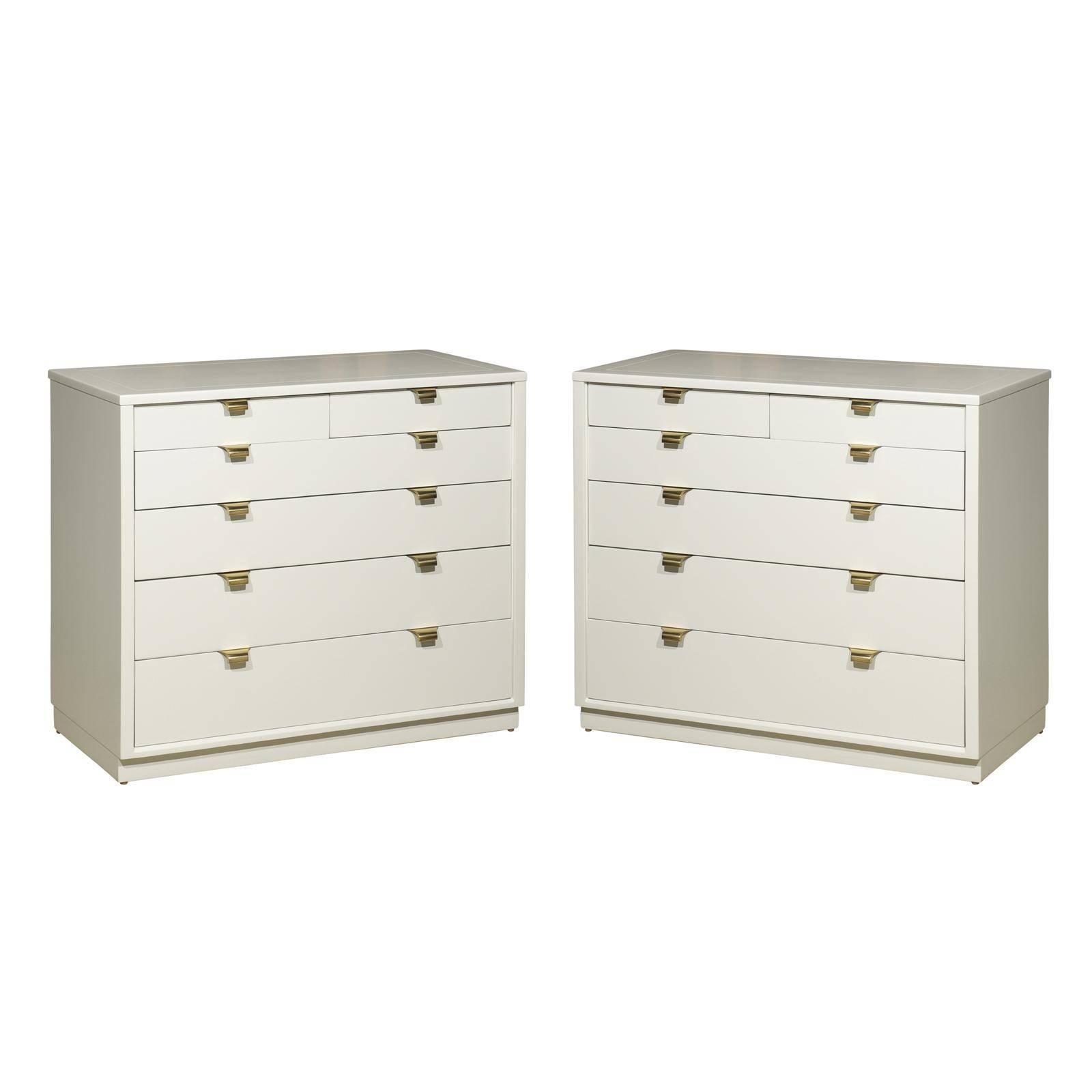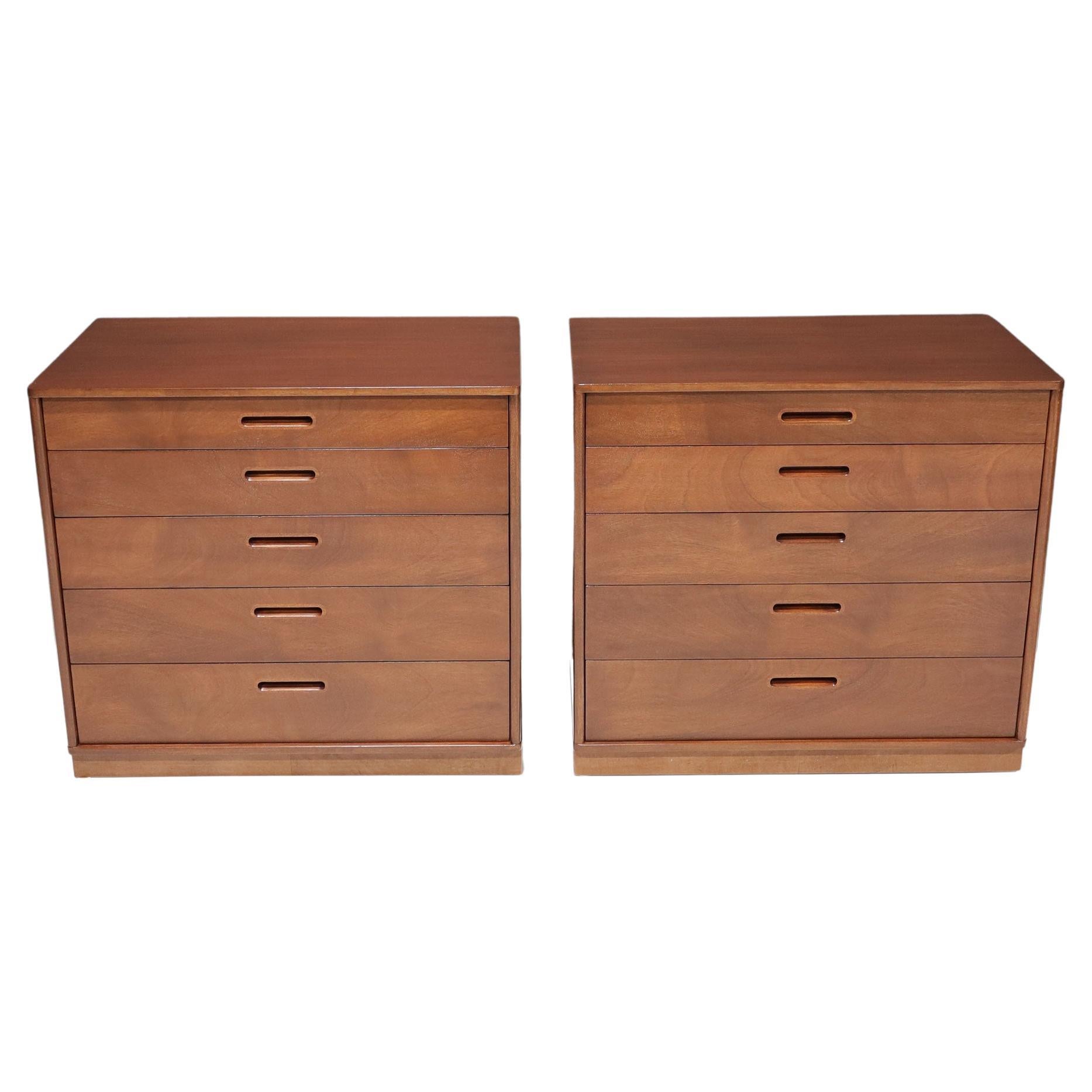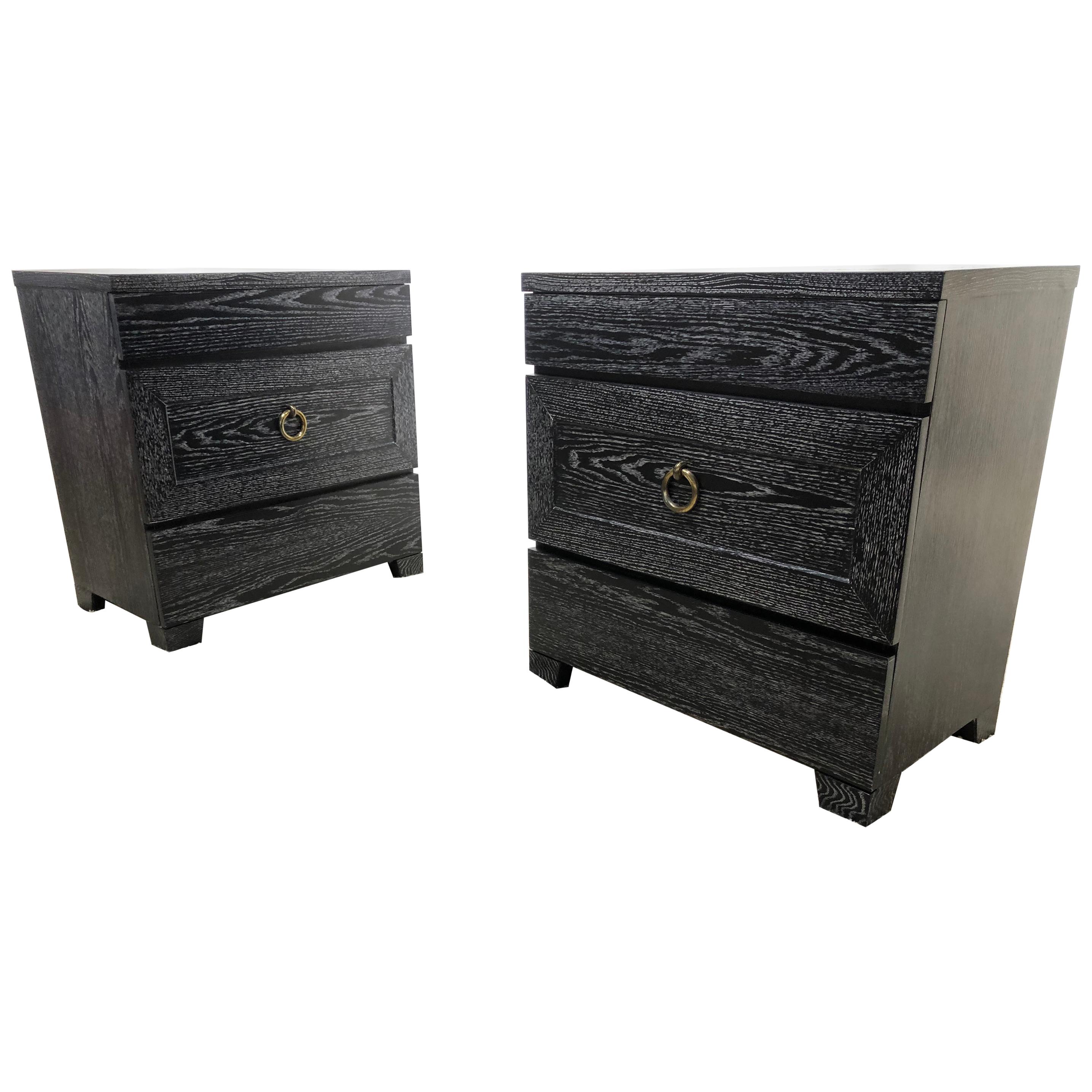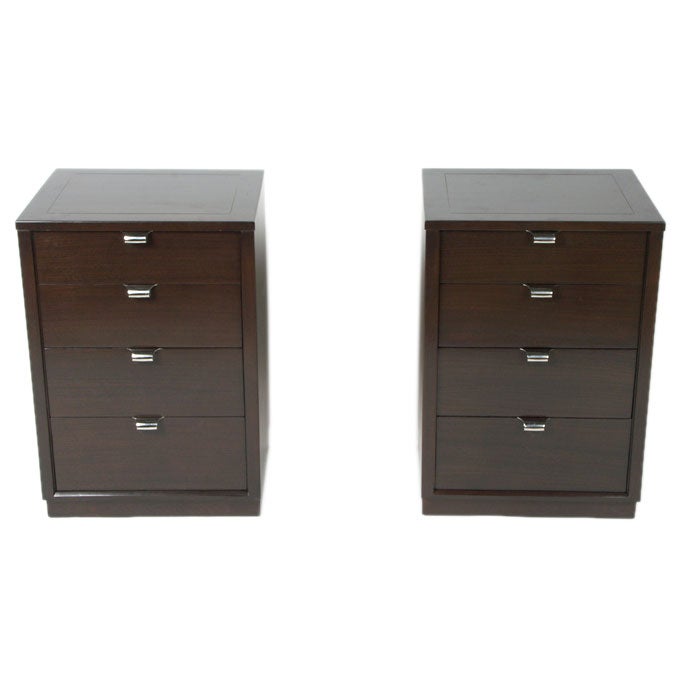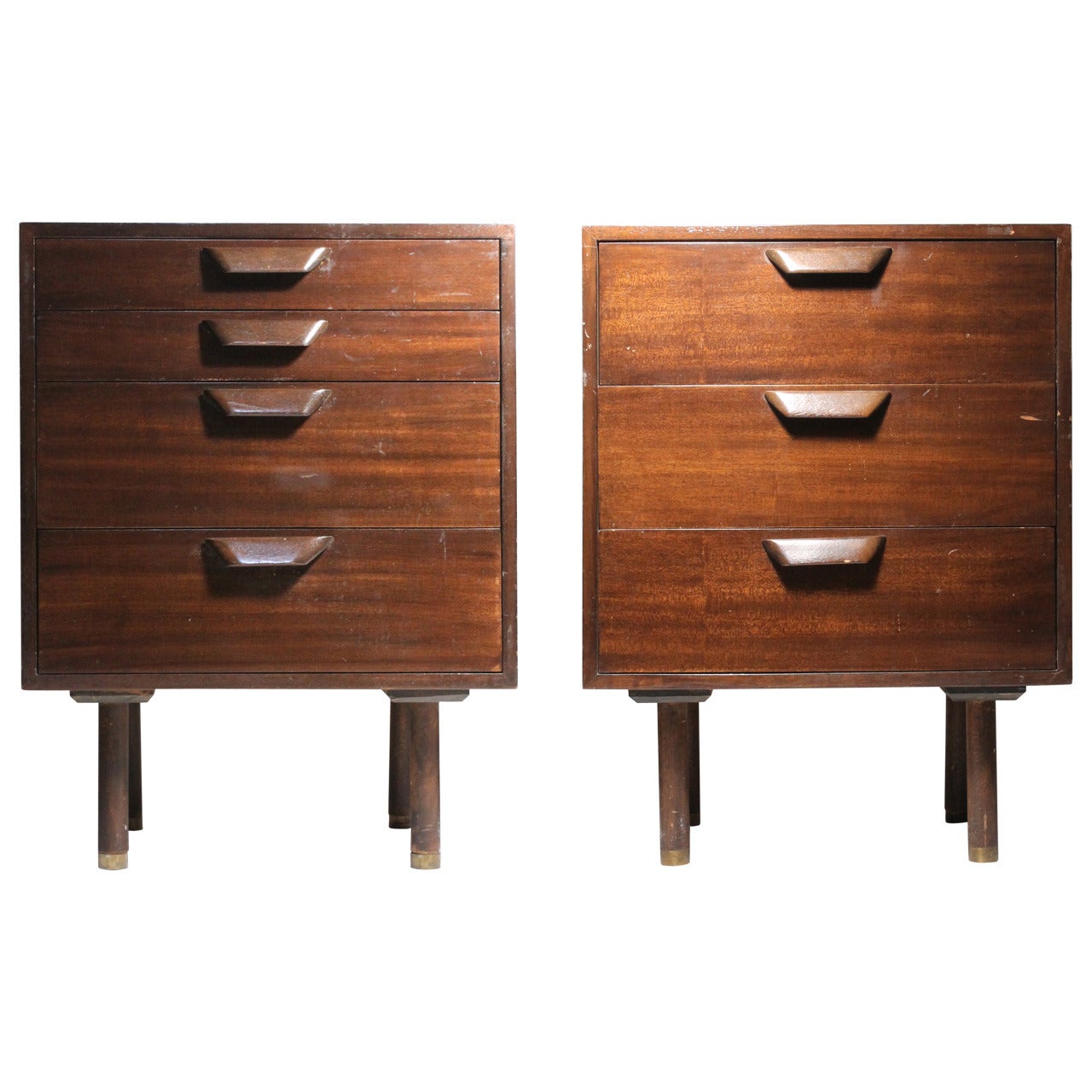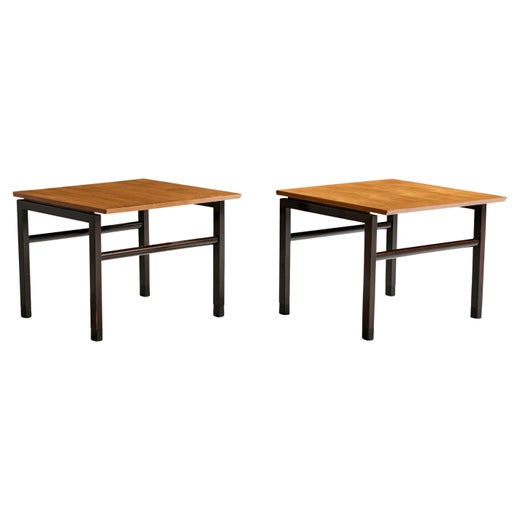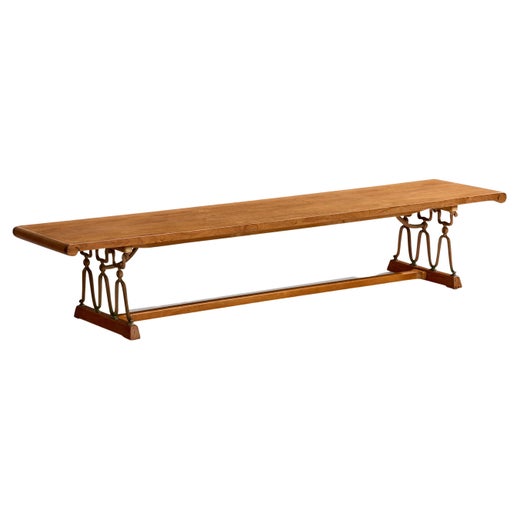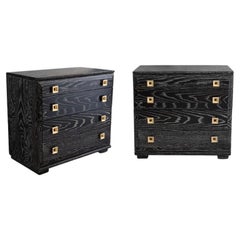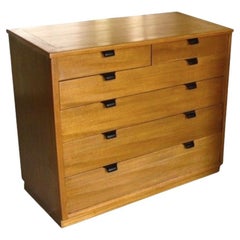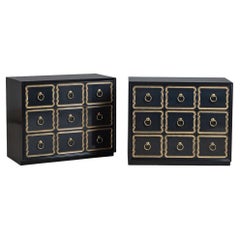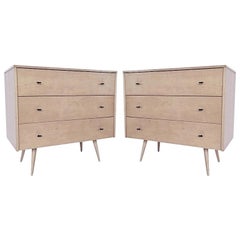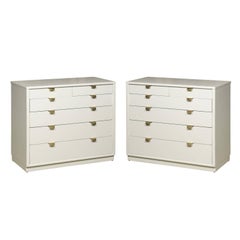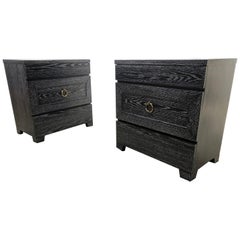Restored Nighstand Chests by Edward Wormley, 1940's
About the Item
- Creator:Drexel (Manufacturer),Edward Wormley (Designer)
- Dimensions:Height: 29 in (73.66 cm)Width: 20 in (50.8 cm)Depth: 17.5 in (44.45 cm)
- Sold As:Set of 2
- Style:Mid-Century Modern (Of the Period)
- Materials and Techniques:
- Place of Origin:
- Period:
- Date of Manufacture:circa 1947
- Condition:Refinished. Great restored vintage condition, displays beautiful patina, brass hardware hand polished. For refinishing or lacquering, inquire for details.
- Seller Location:Dallas, TX
- Reference Number:1stDibs: LU4528239775702
Edward Wormley
As the longtime director of design for the Dunbar furniture company, Edward Wormley was, along with such peers as George Nelson at Herman Miller Inc., and Florence Knoll of Knoll Inc., one of the leading forces in bringing modern design into American homes in the mid-20th century. Not an axiomatic modernist, Wormley deeply appreciated traditional design, and consequently his vintage seating, storage cabinets, bar carts and other work has an understated warmth and a timeless quality that sets it apart from other furnishings of the era.
Wormley was born in rural Illinois and as a teenager took correspondence courses from the New York School of Interior Design. He later attended the Art Institute of Chicago but ran out of money for tuition before he could graduate. Marshall Field hired Wormley in 1930 to design a line of reproduction 18th-century English furniture; the following year he was hired by the Indiana-based Dunbar, where he quickly distinguished himself. It was a good match.
Dunbar was an unusual firm: it did not use automated production systems; its pieces were mostly hand-constructed. For his part, Wormley did not use metal as a major component of furniture; he liked craft elements such as caned seatbacks, tambour drawers, or the woven-wood cabinet fronts seen on his Model 5666 sideboard of 1956. He designed two lines for Dunbar each year — one traditional, one modern — until 1944, by which time the contemporary pieces had become the clear best sellers.
Many of Wormley’s signature pieces — chairs, sofas, tables and more — are modern interpretations of traditional forms. His 1946 Riemerschmid Chair — an example is in the collection of the Museum of Modern Art — recapitulates a late 19th-century German design. The long, slender finials of his Model 5580 dining chairs are based on those of Louis XVI chairs; his Listen-to-Me Chaise (1948) has a gentle Rococo curve; the “Precedent” line that Wormley designed for Drexel Furniture in 1947 is a simplified, pared-down take on muscular Georgian furniture. But he could invent new forms, as his Magazine table of 1953, with its bent wood pockets, and his tiered Magazine Tree (1947), both show. And Wormley kept his eye on design currents, creating a series of tables with tops that incorporate tiles and roundels by the great modern ceramicists Otto and Gertrud Natzler.
As the vintage items on 1stDibs demonstrate, Edward Wormley conceived of a subdued sort of modernism, designing furniture that fits into any decorating scheme and does not shout for attention.
Drexel
While vintage Drexel Furniture dining tables, dressers and other pieces remain highly desirable for enthusiasts of mid-century modern design, the manufacturer's story actually begins decades before its celebrated postwar-era Declaration line took shape.
In 1903, in the small town of Drexel in the foothills of North Carolina’s Blue Ridge Mountains, six partners came together to found a company that would become one of the country’s leading furniture producers. The first offerings from Drexel Furniture were simple: a bed, washstand and bureau all crafted from native oak wood, sold as a bedroom suite for $14.50.
One of Drexel’s early innovations was to employ staff designers, something the company initiated in the 1930s. This focus on design, which few other furniture companies were committing to at the time, allowed Drexel to respond to a variety of new and traditional tastes. This included making pieces inspired by historic European furniture, like the popular French Provincial–style Touraine bedroom and dining group that borrowed its curves from Louis XV-era furniture. Others replicated the ornate details of 18th-century chinoiserie or the embellishments of Queen Anne furniture. Always ready to adapt to new customer demands, during World War II, Drexel built a sturdy desk designed especially for General Douglas MacArthur.
In the postwar era, Drexel embraced the clean lines of mid-century modernism with the Declaration collection designed by Stewart MacDougall and Kipp Stewart that featured elegant credenzas and more made in walnut, and the Profile and Projection collections designed with sculptural shapes by John Van Koert. In the 1970s, Drexel introduced high-end furniture in a Mediterranean style.
Drexel changed hands and visions throughout the years. It was managed by one of the original partners — Samuel Huffman — until 1935, at which time his son Robert O. Huffman took over as president. It was then that the company began to expand, with several acquisitions of competitors in the 1950s, including Table Rock Furniture, the Heritage Furniture Co. and more.
With the manufacturer’s success — spurred by its embrace of advertising in home and garden magazines — it opened more factories in both North and South Carolina. By 1957, the company that had started with a factory of 50 workers had 2,300 employees and was selling its furniture nationwide.
Drexel underwent a series of name changes in its long history. Its acquisition of Southern Desk Company in 1960 bolstered its production of institutional furniture for dormitories, classrooms, churches and laboratories.
In the following decades, contracts with government agencies, hotels, schools and hospitals brought its high-quality furniture to a global audience. U.S. Plywood-Champion Papers bought Drexel Enterprises in 1968, and it became Drexel Heritage Furnishings.
In 2014, the last Drexel Heritage plant, in Morganton, North Carolina, closed its doors. The company rebranded as Drexel in 2017.
The vintage Drexel furniture for sale on 1stDibs includes end tables designed by Edward Wormley, walnut side tables designed by Kipp Stewart and lots more.
- ShippingRetrieving quote...Shipping from: Dallas, TX
- Return Policy
More From This Seller
View AllVintage 1940s American Mid-Century Modern Commodes and Chests of Drawers
Gold
Vintage 1940s American Mid-Century Modern Commodes and Chests of Drawers
Brass
Vintage 1950s American Commodes and Chests of Drawers
Gold
Vintage 1950s American Mid-Century Modern Commodes and Chests of Drawers
Metal
Vintage 1970s American Mid-Century Modern Night Stands
Brass
Vintage 1970s American Mid-Century Modern Commodes and Chests of Drawers
Brass
You May Also Like
Vintage 1940s American Mid-Century Modern Commodes and Chests of Drawers
Brass
Mid-20th Century American Mid-Century Modern Commodes and Chests of Drawers
Mahogany
Early 20th Century American Mid-Century Modern Commodes and Chests of Dr...
Metal
Vintage 1940s American Mid-Century Modern Night Stands
Brass
Vintage 1940s American Mid-Century Modern Commodes and Chests of Drawers
Brass
20th Century American Mid-Century Modern Commodes and Chests of Drawers
Wood
